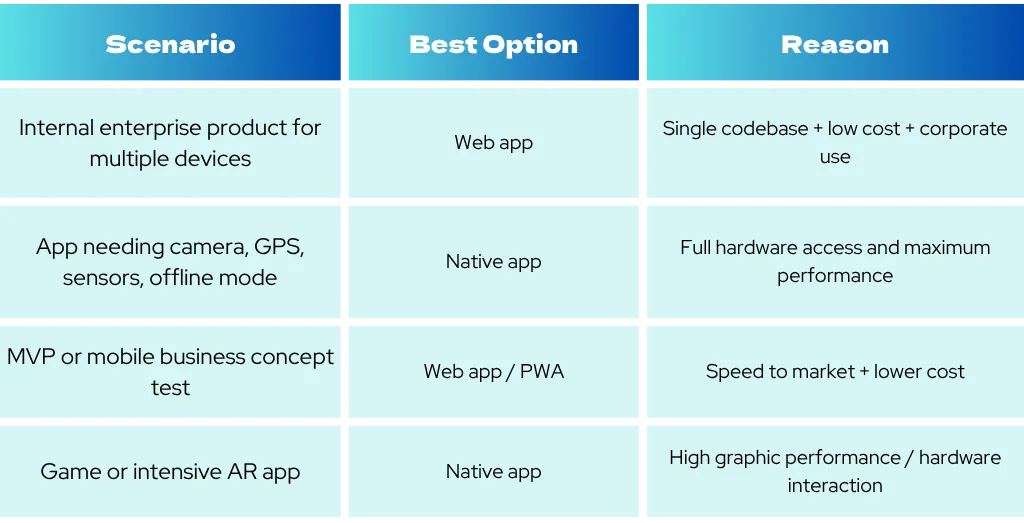In today’s digital era—where users demand fast, seamless, and cross-platform mobile experiences—many companies face a fundamental strategic decision: develop a native app for iOS/Android or opt for a web app that runs via browser? This dilemma isn’t just technical—it affects timelines, costs, maintenance, and user experience. In this article, we’ll explore what web applications are, how they differ from native apps, the pros and cons of each, and when it’s best to use one model over the other.
What Are Web Applications? Examples Included
A web application is software accessed through a browser (such as Chrome or Safari), without needing to be installed via an app store. The user opens a URL and starts interacting with an experience comparable to an app.
Examples of web applications include:
- A task management system that runs entirely in a mobile or tablet browser.
- A corporate intranet accessible from mobile/desktop without download.
- A Progressive Web App (PWA) that allows lightweight installation and offline functionality.
These web applications are a lighter alternative to traditional native apps, enabling access to multiple devices through a single codebase.

Main Features of Web Applications
Web applications stand out for several features that make them unique compared to a simple website or native app:
- Accessible via browser—no need for app store downloads.
- Common codebase, allowing operation on multiple operating systems (iOS, Android, Windows) with less duplication.
- Instant updates, since the server powers the app and users always see the latest version.
- Dependence on an internet connection (though PWAs can work partially offline).
- Generally, less access to deep device features (sensors, camera, etc.) compared to native apps.
In summary: web applications allow broad reach with less effort but sometimes sacrifice performance or deep hardware integration.
Differences Between Web and Native Mobile Applications
When we talk about native applications, we refer to apps specifically designed and compiled for an operating system (e.g., iOS or Android) and installed from an app store. These differ from web applications in several key ways:

These differences help determine which type of app fits your needs, budget, time to market, and desired user experience.

What Functions Define Web Applications?
- Web frontend built with HTML, CSS, and JavaScript, adaptable to mobile and desktop.
- Backend or server managing logic, data, authentication, APIs, etc.
- Database for data persistence.
- Responsive or adaptive architecture so the UI displays well on various screen sizes.
- Optional offline or app-like functionality (in PWAs) through technologies like Service Worker or Web App Manifest.
In summary: a well-designed web application should meet accessibility, adaptability, functionality, and performance requirements.
Types of Web Applications: Classifications
- Standard web app: runs in the browser, requires internet, no installation.
- PWA (Progressive Web App): a web app that 'behaves like native'—can be lightly installed, send notifications, and work partially offline.
- Responsive/multiplatform web app: designed to adapt to both mobile and desktop.
- Hybrid app (technically a 'packaged web app'): built with web technologies but packaged for app stores (via frameworks like Cordova/Ionic).
Thus, when discussing 'web applications,' it’s important to clarify the desired level of functionality.
Advantages of Web Applications
- Cross-platform reach: a single version works on multiple devices, reducing time and cost.
- Instant updates: no need for app store approvals.
- Faster time to market: skipping platform-specific development means quicker launch.
- Lighter for the user: no heavy installation or extra storage required.
- Better for SEO and web discovery: browser access without download barriers increases visibility.
These advantages make web apps a common choice for startups or MVPs instead of native apps.
How Are Web Applications Developed? Structure Explained
- Definition and architecture: define the problem, users, and features.
- Responsive UX/UI design: layouts that adapt to mobile and desktop.
- Frontend development: HTML + CSS + JavaScript (or frameworks like React, Vue, Angular).
- Backend & API development: logic, database, integrations, authentication.
- Testing and performance: ensure performance across devices, check speed and compatibility.
- Deployment and maintenance: hosting, updates, and monitoring.
A typical web app structure includes: presentation layer (frontend), business layer (backend), data layer (database), and services layer (APIs/external services). For PWAs, a 'shell' architecture can be used: the main content loads first, while data updates in the background.
Key elements of a web app include: home/login page, user dashboard, adaptive menu, notification system, server connectivity, error handling, security (HTTPS, authentication), and device compatibility.
Illustrative Examples and Key Comparative Advantages

Is a Mobile App or Web App Better?
The choice between mobile web apps and native apps isn’t about 'better or worse,' but rather 'better for a specific case.' Web apps offer reach, agility, and lower costs, while native apps provide superior performance, integration, and high-quality user experience. Understanding what web applications are, their features, how they’re developed, and when each type makes sense is key for strategic decision-making.
In a world where users demand flawless mobile experiences, the answer isn’t always 'more technology,' but rather 'technology applied wisely.' Whether you choose web or native, the goal remains the same: create mobile experiences that engage, perform, and stay sustainable.




.png)